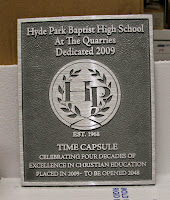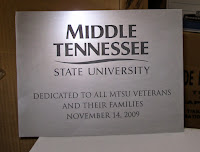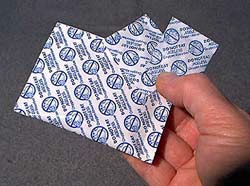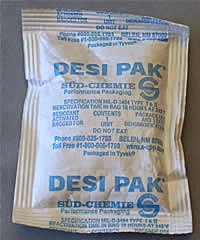Time Capsules with Harsh Conditions
 |
Cemeteries in areas such as Key West and New Orleans
face harsh conditions, and so would any time capsules
buried in such areas. (Photo: Marc Averette, Wikimedia) |
Should you use a vault for your next groundbreaking time capsule?
No, not necessarily. But sometimes there are reasons for encasing a time capsule in a vault. Let's discuss those.
Environmental Considerations
If environmental conditions are harsh during the time the capsule lies in place, you may need to give it extra protection.
When it's under water
Poor conditions can be as simple as the area getting more water from above or below sea level than normal. For instance, Florida's Key West area is a terrible place to bury a time capsule because it's below sea level. In their case, they used some extra protection from the water coming up from below the
time capsule placement.
When it's in earthquake country
Are you in earthquake country, such as California, or will the area be earthquake prone in the future? This is a harsh condition. In such a scenario, the vault will provide some protection from earth movement around the time capsule. In general, if you expect an earthquake of 7.5 or more during the time of interment, consider a vault to enclose the time capsule.
How Long Before the Time Capsule is Opened?
If the time expected before opening is longer than 100 years, you should consider a vault. You will likely not be the one to open the time capsule in the future. You do not know the future conditions over time. What if earth-moving equipment comes along and pierces the container? In this case, a vault provides physical and mechanical protection. Such equipment will hit the vault before it hits the time capsule. That's a good thing.
Questionable Time Capsule Containers
Is there a reason for you not to trust the time capsule container's protection? Do you suspect its quality? Consider the material used to make the container, the material used to make the seal, and the design. You can buy a time capsule container today made out of various materials. Common materials include stainless steel, plastic, aluminum, and 'composites'.
Container Materials to Question
 |
An example of a time capsule burial showing drainage on
Example of burial for a time capsule
and provide shoulder for plywood cover. (Image courtesy of
Future Packaging and Preservation) |
Certain materials used for time capsules are 'iffy.' They may be okay, but you should consider their shortcomings.
Plastic
If the time capsule is plastic, this material is subject to cracking. In this case, you should consider a short period of interment and a vault to enclose it.
Mild Steel
If the time capsule material is mild steel (or stainless 302 or below, or regular steel), the material corrodes in just a short time. One way to extend the life of a metal is to paint it. For instance, some people think to use a surplus 'ammo' can for their time capsule. It's cheap enough. But the material of a surplus 'ammo' can is mild steel, and it will corrode. It's usually painted with an olive drab paint. This serves to slow corrosion for a time, but it will not prevent it. Also, the ammo can has a plain rubber gasket seal that will crack over time. The ammo can is a poor choice for a time capsule container, whether you use a vault or not.
Composite Material - define it!
If you choose a time capsule made of a 'composite' material, know what each of the materials in the composite is. Then check the aging characteristics of each and the capsule design. As of this writing I could not find enough details from the manufacturer's websites to make a good report. You will find that the companies selling time capsules made of 'composite materials' are vague in their descriptions. It's not important that the material withstand 1000 degrees or that it withstand high pressure. Time capsules do not experience such conditions. It's important that your time capsule does not corrode. It's also important that the seal does not leak. Beware of these marketing oriented sites. They want to do one thing - sell you their stuff.
Thin Aluminum
If you choose an aluminum time capsule, be sure that it's thick enough to withstand oxidation and corrosion. It will corrode over time and it's subject to having its oxidation layer scratched. It should be 1/4" or more in thickness. Also, ask what kind of aluminum the container is. Some alloys are better able to withstand corrosion than others.
Cheap Mild Steel or 302 Stainless Steel
Do not use mild steel, and beware of 302 stainless steel. This grade of stainless steel is not much better for resisting corrosion than painted mild steel! As with aluminum, stainless steel has various grades. Use only 304 or better (316 is fine but difficult to fabricate).
How Does Your Time Capsule Seal?
Sealing Material
 |
"Mistress Mary, Quite Contrary, How
does your Time Capsule Seal? (Image from
http://www.gutenberg.org/etext/18546) |
It's important to consider how your time capsule seals. Not only is the design of the time capsule closure important, the material used to seal it up is important, too. The material used for the time capsule container is the most important thing to consider. How it seals is the next most important consideration.
The way a time capsule seals is a prime way for moisture to get inside and ruin your contents. What material makes up the seal? It's usually called an "O-ring" or "gasket." If it's made of rubber or elastomer, you should ask, "What are its aging characteristics? That's most important for time capsules.
Take a look at the shelf life of the material. Pay no attention to how it performs for chemical or temperature or pressure resistance. Aging is the most important characteristic for time capsules. For our time capsules, we chose Silicone Rubber (an elastomer). It has excellent resistance to ozone, weathering and aging. It has an unlimited shelf life. If the sealing material for your time capsule is a rubber other than silicone, you are asking for trouble. To see an example of a design that uses this seal, see our
Bolted Time Capsule Boxes.
Sealing Design
The design of a time capsule seal is important. Does it allow for moisture to get through or around the seal and into the capsule? Besides the material of the seal, does the design of the time capsule closure make sense?
If the time capsule closes via a gasket or O-ring, does the design make it 'blind'? Our
FPP Bolted Time Capsule features Blind Seal. First, an o-ring groove allows the silicone o-ring to fit exactly inside. We doubt that moisture will get past the o-ring, but if it does, we cap off the bottom of each bolt hole to make double sure. If the formed gasket just sits there, flat, consider what would happen if the gasket material cracked over time. Would it allow any moisture to get through?
Vaults Not Always Best
If you construct a vault, or use a pre-fabricated one, pay attention to how it drains.
As for placement, the time capsule should not receive more water than usual, such as would placement in a garden setting. In the same vein, never wrap our time capsules in plastic. The plastic will hold moisture to the metal, and instead of protecting it, it would hasten corrosion over time. Do research into concrete that claims to be waterproof. Know its limitations. Use a sturdy container inside of it. But ALWAYS allow the vault to drain for above sea level placement.
Leaky Time Capsules
 |
In 2013 UNMC opened a time capsule from 1993
only to find a leaky disappointment. (Image courtesy of
University of Nebraska Medical Center) |
In 2013, the University of Nebraska Medical Center (UNMC) opened a time capsule from 1993. They found a leaky disappointment.
This example of a container that leaked is sobering. Opened after it was in the ground only 20 years,
this UNMC time capsule was full of water and muck.
Can anyone tell me what the material was? It appears to be a mild steel or galvanized metal.
The Material We Use
For your time capsule container, you want the properties of the metal that you choose to be the least corrosive possible. For our time capsules, we use only
304 or 304L stainless steel. You do not need to worry about our thickness or our methods of sealing. We use stainless steel 304 or 304L (low carbon). They are good choices to resist corrosion, and they are sturdy when buried. Another good choice is 316 stainless steel, but it is more difficult to fabricate. We provide warranties for our time capsule boxes.
See the main site over at Future Packaging and Preservation for stainless steel time capsules.
The Best for Burial
Choose the Bolted Time Capsule Boxes for burial up to 100 or more years. Next best is the Capped Time Capsule Boxes (up to 75 years). Yes you can bury the Family Time Capsules and School Time Capsules (Mr Future 6x24 and Mrs Future 5.5x22) up to 60 years or so. All capsules come with hints for burial, and the capsules should always be buried vertically so that their cap is oriented on top.
If you would like to contact us, please give us a call. You can also contact us using this form on our site: CONTACT US TODAY!









